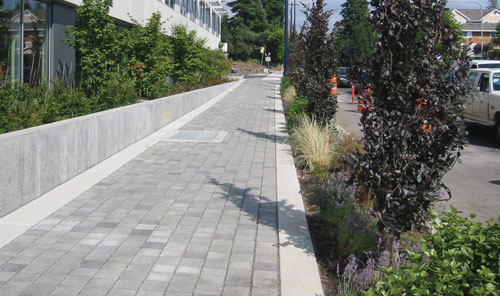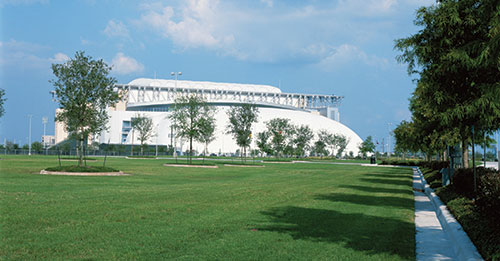Design Options for Greening Urban Environments
| Utilities and Urban Green Space Seattle, Washington |
||
Among the key benefits to modular underground bioretention cells in an urban environment is that they allow existing utilities to stay in place because the system is modular and can be constructed around them. This can be a major construction cost savings. There are a number of simple ways to work with and around utilities using these cells. Use of modular underground bioretention cells around existing utilities was a factor considered by the designers of the Aurora Avenue Secret Rain Garden along Route 99 near Seattle, Washington. A rain garden was designed along one side of a road way to provide a separation for pedestrians. The designer, Curtis LaPierre, Otak, Inc., created a system that integrated permeable pavers, curb cuts and modular underground bioretention cells. The cells extend the rain garden underneath the pavement, the stormwater from the road enters the rain gardens through the pavement and curb cuts and is absorbed into the soil, providing irrigation for the plantings and recharging the groundwater. The project area had a limited right of way and large paved areas. The solution provided additional traffic lanes, wider sidewalks, better stormwater management and increased green space. Modular underground bioretention cells are designed to meet AASHTO H-20 loading standards. When considering the use of these cells for your site, it’s important to specify soil volumes that are appropriate for both mature tree growth and stormwater management. As more municipalities update their codes and design guidelines for increased onsite stormwater management and increased urban forest canopy, modular underground bioretention cells provide an option for achieving both these criteria in a single system. These cells provide the structure to support pavement while creating an underground vault for containing soil and managing water. This integrated system of structural soils and underground bioretention cells provides a larger and better planting medium for urban trees, creates a simple and effective method of capturing and treating rain and stormwater at source, and allows designers to plan for more extensive, functional, and sustainable urban green space. |
| Grass Pervious Flexible Pavement Systems | ||
The parking lot at Reliant Stadium includes seven acres of pervious flexible pavement system, making it the largest grass-porous paving system in the world. This grass replaces seven acres of asphalt and it has cooled the site sufficiently to allow almost three more months of use during the year. This porous grass parking lot has the ability to store and clean 60,000 cubic feet of stormwater, thus preventing down stream flooding and non-point source pollution. In addition, trees can now survive in this parking lot as the permeable nature of the surface provides sufficient air and water to the tree’s root zone. The increased forest canopy has increased shade and reduced the heat island effect. |











